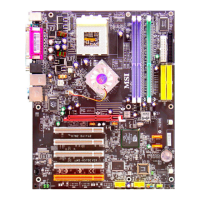
Do you have a question about the MSI K7N2 Delta2 - Motherboard - ATX and is the answer not in the manual?
| Product Type | Motherboard |
|---|---|
| Form Factor | ATX |
| Chipset | NVIDIA nForce2 Ultra 400 |
| Maximum Memory | 3 GB |
| Supported Memory Types | DDR SDRAM |
| Expansion Slots | 1 x AGP 8x, 5 x PCI |
| Audio Codec | Realtek ALC655 |
| Audio Output | 6-channel |
| LAN Controller | Realtek RTL8201BL |
| Supported CPU | Athlon XP, Duron |
| Socket | Socket A |
| Memory Slots | 3 x DIMM |
| Supported RAM Speeds | 266 MHz, 333 MHz, 400 MHz |
| Storage Interfaces | 2 x ATA-133, 2 x SATA |
| LAN | Ethernet |
| LAN Ports | 1 |
| USB Ports | 6 |
Legal notice regarding intellectual property and usage rights.
List of registered trademarks and their owners.
Records changes and release dates of the manual.
Information on how to obtain assistance and resources for technical issues.
Crucial guidelines for safe operation and handling of the equipment.
Detailed technical specifications of the K7N2 Delta2 Series ATX Mainboard.
Diagram illustrating the physical layout and component placement of the mainboard.
List of items included in the product package.
Visual guide identifying key components and their locations on the mainboard.
Information on CPU installation, core speed derivation, and cooler setup.
Information on memory module installation, types, and compatibility.
Details on connecting ATX power supply connectors to the mainboard.
Description of connectors available on the mainboard's rear I/O panel.
Details on mouse, keyboard, VGA, serial, USB, LAN, SPDIF, and audio ports.
Overview of internal connectors like floppy, fan power, IDE, and SATA.
Information on front panel connectors, USB headers, IEEE 1394, and IrDA.
Explanation of jumper settings, including the Clear CMOS jumper.
Description of AGP and PCI slots for expansion cards and interrupt routing.
Instructions on how to access the BIOS setup utility.
Defines keyboard keys for BIOS navigation and interaction.
Lists main BIOS setup categories and key configuration options.
Settings for Standard CMOS Features, Advanced BIOS Features, and Chipset.
Configuration for Integrated Peripherals, Power Management, and PNP/PCI.
System status monitoring and advanced CPU/AGP/DRAM tuning options.
Options for loading defaults, setting passwords, and saving/exiting BIOS.
Settings for CPU clock, DRAM frequency, timings, and performance modes.
Options for CPU and AGP voltage, FSB frequency, and dynamic overclocking.
Fine-tuning options for DRAM timings (CAS Latency, T-RAS, etc.) and AGP clock.
Settings to enable/disable Spread Spectrum for FSB and AGP to reduce EMI.